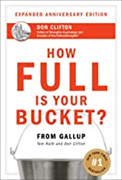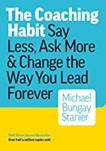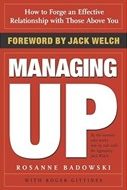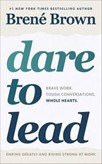BSC Book Review
by Hilary Ashmen, M.Ed., BSC Consultant

How Full is Your Bucket?
Tom Rath and Don Clifton
Gallup Press | 2015 | 128 pp. | ISBN 9781595620033
Welcome to our leadership resources book review to facilitate your continued growth and move your ideas to action. This month we add How Full is Your Bucket? by Tom Rath and Donald O. Clifton to your professional reading list and provide reflection from Hilary Ashmen, M.Ed.
How Full is Your Bucket? illustrates the importance of every interaction in our lives. The metaphor of filling and dipping into your bucket aligns with the impacts of positive and negative experiences. Donald O. Clifton is considered the father of strengths psychology and together with his grandson/co-author, Tom Rath, show the cumulative results of both exchanges to all aspects of your journey. Vivid and enlightening examples, scenarios, statistical data, and action strategies are used to transform lives.
This book spoke to me, as it described the range of emotions and how they can have a profound effect on your well-being. I reflected on the choices that I make consistently to either fill or dip into my own bucket and the buckets of others. Rath described the love and reinforcement that he received in his childhood, as his relatives and encouraged him to develop his talents. He details how this inspired him to thrive and achieve his entrepreneurial goals. The constant support that he received helps him as he manages a chronic illness. Positive sentiments, such as he received, build a safeguard that carries an individual through crises. During COVID-19, the world has been faced with unprecedented challenges. The mental health issues associated with isolation, fear, and uncertainty have taken their toll on so many in our society. Ensuring that I inspirit my network with positivity is one way of controlling what I can. Filling buckets of others promotes resilience and coping mechanisms that are essential to successfully navigating through the storms, especially COVID-19.
I felt validated reading this book and the suggestions on how to build a culture of care and support. Yet, I was also able to learn new techniques and develop a renewed urgency to embrace the concepts of filling buckets with individualized kudos. Not only does this motivate, but it also spreads to others to model the method. A utopian atmosphere at home and at work helps me to stay healthy and live in the present moment. Commending my clan not only lifts them up, but it enhances my life as well.
According to Rath and Clifton (2015), 65% of Americans said they had not received any acknowledgement professionally in the past year. The lack of praise and relevant accolades can result in low morale, and it can be counterproductive for organizations or personal relationships. In fact, the authors explain that employees who are actively disengaged can do more harm by going to work than if they were paid to stay home and do nothing. This is also true in personal connections. When a partner is only hearing complaints, they may shut down and retreat. However, one scenario in the book described a woman who decided to only point out the favorable things rather than the unsatisfactory. It dramatically improved her marriage and made a more meaningful connection with her spouse.
Since reading this book, I have been intentionally thinking about my actions and behavior at home and at work. How do the people around me want to be recognized and appreciated? Am I filling someone’s bucket or dipping into it as a result of my words or actions? The authors outline five strategies to filling buckets with distinctive, personalized commendations. I will start by zeroing in on two of the strategies: “Shine a Light on What Is Right” and “Reverse the Golden Rule.”
“Shine a Light on What Is Right” helps to focus on the commendable rather than criticizing. This shifts the perspective and reinforces attitudes, behaviors, and performance to stimulate growth and trust. To assist with this strategy, Rath and Clifton include a 15 question “Positive Impact Test” to impart necessary skills for the “how” of bucket filling. “Reverse the Golden Rule” is a variation of the Golden Rule. Rather than “do unto others as you’d have done unto you”; practice “Do unto others as they would have you do unto them.” While I might prefer to be recognized in front of a large group, some might be mortified and embarrassed. My plan is to take the time and reflect on my village and make certain that I ask them questions from “The Gallup Recognition Interview.” These questions ask others about their preferences like what are your hobbies and interest, what name do you like to be called?
When you find yourself needing to improve your personal or professional surroundings, How Full is Your Bucket? is an excellent resource. This book is engaging and easy to follow. Graphics with key statistics and information highlight the importance of having a full bucket and filling the buckets around you. Resources, implementation strategies, and reflection questions make it simple to share with friends, family, and colleagues to spread the joy of a promising, uplifting, bucket filling life.
How Full is Your Bucket? is recommended for…
- Anyone ready to energize their personal and professional relationships
- Those needing encouragement and a path to building a strengths-based environment using praise, recognition, and appreciation as the foundation to increasing productivity
Cite: Ashmen, H. (2021). BSC Book Review: How Full is Your Bucket?. Rockville, MD: BSCorbett Consulting, LLC. Retrieved from https://bscorbettconsulting.com/portfolio/how-full-is-your-bucket






